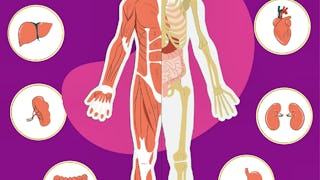Course 5 examines the role of anthropometrics, biomechanics and motor skills in human performance as well as key factors that influence how humans produce and sense motion, and how these can be applied to training and testing performance.

Enjoy unlimited growth with a year of Coursera Plus for $199 (regularly $399). Save now.

Anthropometry, Biomechanics, and Motor Skills in User Design
This course is part of Human Factors & Usability Engineering: Designing for Humans Specialization

Instructor: Robert Gray
Included with
(13 reviews)
Recommended experience
What you'll learn
You will be introduced to types of controls, be able to understand and identify key factors that influence how humans produce & sense motion.
Skills you'll gain
Details to know

Add to your LinkedIn profile
4 assignments
See how employees at top companies are mastering in-demand skills

Build your subject-matter expertise
- Learn new concepts from industry experts
- Gain a foundational understanding of a subject or tool
- Develop job-relevant skills with hands-on projects
- Earn a shareable career certificate

There are 5 modules in this course
This course explores anthropometry, biomechanics, and motor skills. You will learn about measuring human body dimensions and characteristics, known as anthropometrics, and how these measurements are used in design. The course covers factors influencing motion production and perception, including open- and closed-loop control and stimulus-response compatibility. You will also explore the applications of motion-tracking technologies in training and testing human performance.
What's included
1 video1 reading
Module 1 explores anthropometry and ergonomics, covering the measurement of human body dimensions and the importance of anthropometric data in fields like product design and workspace layout. The module also focuses on ergonomics, the science of designing products and environments to fit human capabilities and enhance safety and efficiency. You will learn about the principles and goals of ergonomics, as well as ergonomic design considerations for creating user-centered products and workspaces.
What's included
3 videos6 readings1 assignment1 discussion prompt
In Module 2, we dive into the realm of ergonomics research, exploring various applications in different settings. We begin with Lesson 1, focusing on office design and exercise, aiming to create the perfect ergonomic workspace. Moving on to Lesson 2, we shift our attention to factories and industrial settings. In Lesson 3, we turn our focus to the healthcare sector.
What's included
3 videos6 readings1 assignment1 discussion prompt
In this module, we explore the field of biomechanics, which focuses on studying the mechanics and movement of the human body. We will cover various aspects of biomechanics, including its definition, applications in different domains, and methods for analyzing human movement. By the end of this module, you will have a solid understanding of biomechanics principles and how they are used to study and analyze human motion.
What's included
3 videos6 readings1 assignment1 discussion prompt
Module 4 focuses on the practical applications of biomechanics in various fields. It explores how biomechanics can be utilized to optimize performance, prevent injuries, and enhance movement in sports, rehabilitation, ergonomics, and other contexts.
What's included
3 videos8 readings1 assignment
Earn a career certificate
Add this credential to your LinkedIn profile, resume, or CV. Share it on social media and in your performance review.
Instructor

Offered by
Explore more from Mechanical Engineering
 Status: Free Trial
Status: Free TrialUniversity of California San Diego
 Status: Preview
Status: PreviewThe Chinese University of Hong Kong
 Status: Free Trial
Status: Free TrialNational Academy of Sports Medicine
 Status: Preview
Status: PreviewUniversity of Florida
Why people choose Coursera for their career




Frequently asked questions
To access the course materials, assignments and to earn a Certificate, you will need to purchase the Certificate experience when you enroll in a course. You can try a Free Trial instead, or apply for Financial Aid. The course may offer 'Full Course, No Certificate' instead. This option lets you see all course materials, submit required assessments, and get a final grade. This also means that you will not be able to purchase a Certificate experience.
When you enroll in the course, you get access to all of the courses in the Specialization, and you earn a certificate when you complete the work. Your electronic Certificate will be added to your Accomplishments page - from there, you can print your Certificate or add it to your LinkedIn profile.
Yes. In select learning programs, you can apply for financial aid or a scholarship if you can’t afford the enrollment fee. If fin aid or scholarship is available for your learning program selection, you’ll find a link to apply on the description page.
More questions
Financial aid available,





